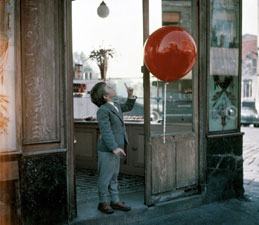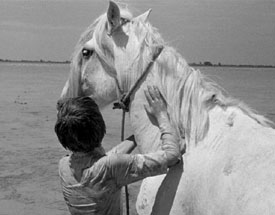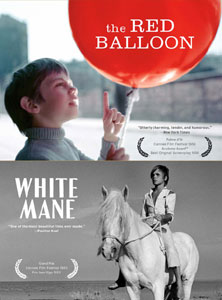 Not a silent film per se, the minimalist dialogue makes Palme d'Or winning The Red Balloon (Le Ballon Rouge, 1956) truly international, conveying its story predominantly through naturalistic mime.
Not a silent film per se, the minimalist dialogue makes Palme d'Or winning The Red Balloon (Le Ballon Rouge, 1956) truly international, conveying its story predominantly through naturalistic mime.
It's the tale of a lonesome boy who encounters a large red balloon which begins to follow him about without needing to be held onto by its string.
One of the few lines of dialogue is "Balloon, you must obey me & be good," & indeed the balloon behaves more like a playful well trained dog than a balloon, exhibiting a distinct personality, a teasing half-obedience, & a great fondness for its boy.
A sweet fantasy with tremendous technicolor cinematography, we see the life & travails of a Parisian child wandering the streets with his friendly round companion. It has much the same sweetness as The Little Fugitive (1953) & even if it hadn't had the fantasy component it would probably have remained a grand little film.
After many endearing sequences the story begins along a trail of tragedy when street ruffians figure out this kid has an obedient balloon. Their jealousies & desire take on a cruel coloration that will lead to a great moment of martyrdom, followed by a closing scene of such transcendent beauty & fantasy it takes the breath away.
I saw this first as a 16 mm film in elementary school, when it was extremely appealing to me for the fantasy of possessing such a loving balloon. I later saw it as a young adult in a fresh 35 mm print on the big screen, together with a rather inappropriate porno spoof of two "romantic" dogs, & at that time realized The Red Balloon held adult interest too. Having lately seen it anew on crisp DVD, I see that it is a visual work of art, a timeless treasure.
 Released on dvd together with The Red Balloon was a black & white short film by the same director, White Mane (Crin Blanc; aka, Cheval Sauvage, 1953), about a boy who sets out to tame a wild horse. Released on dvd together with The Red Balloon was a black & white short film by the same director, White Mane (Crin Blanc; aka, Cheval Sauvage, 1953), about a boy who sets out to tame a wild horse.
It's beautifully filmed with the same visual reliance on mime rather than dialogue, & as it stars a little boy who alone can approach the rogue snow-white stallion, it has obvious appeal for children.
It made a film festival splash on the film festival circuit when it was new, before ever anyone could've guessed the director would make such a great film as The Red Balloon. And it even won a Palme d'Or at Canne.
And yet for my tastes it isn't a strong film. The aggressively masculine narrator is both out of sync with the minimalist dialogue & in fact destroys the atmospheric possibilities of the otherwise near-silent action of the characters. Nor does it match well with the child protagonist.
Imagine The Red Balloon's quietude intruded upon by a loud aggressive adult's voice telling you the balloon is this, the balloon is that. It would've reduced a great film to a fraction of its effectiveness. White Mane has visual excellence, but the narrator ruins it.
It's set in Camargue, France, a warm Mediterrean setting. The scenes of ranchers trying to catch wild horses gives it a bit of the wild west western-film look. The ranchers capture the stallion but the creature is too wild to be saddle-broken & is soon again free.
When the boy Folco (Alain Emery) shows an interest in capturing the stallion himself, the ranchers laughingly tell him he can have the horse if he can catch it, never expecting he could ever do so. Most of the rest of the film is Folco attempting to domesticate White Mane.
White Mane also like Red Balloon ends on a mystic note of fantasy, except it doesn't work this time, since it actually appears pretty certain the horse got the kid killed.
copyright © by Paghat the Ratgirl
|

